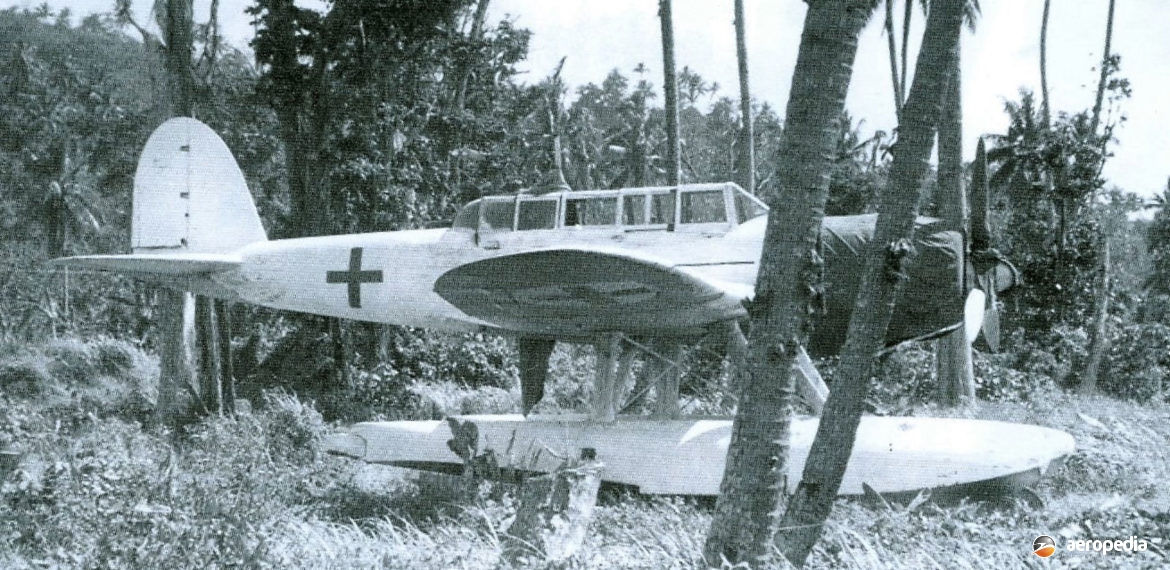Photograph:
Aichi E13A floatplane after surrender at Jacquinot Bay, New Britain 1945 (RNZAF Museum)
Country of origin:
Japan
Description:
Single-engine, twin-float, reconnaissance seaplane
Power Plant:
One 791 kw (1,060 hp) Mitsubishi Kinsei 43 fourteen-cylinder two-row radial air-cooled engine
Specifications:
- Wingspan: 14.5 m (47 ft 6⅞ in)
- Length: 11.3 m (37 ft 6⅞ in)
- Height: 7.4 m (24 ft 3⅓ in)
- Wing area: 36 m² (387.499 sq ft)
- Max speed at 2,180 m (7,155 ft): 377 km/h (234 mph)
- Cruising speed at 2,000 m (6,560 ft): 222 km/h (138 mph)
- Climb to 3,000 m (9,845 ft): 6 min 5 sec
- Service ceiling: 8,730 m (28,640 ft)
- Range: 2,089 km (1,298 miles)
- Empty weight: 2,642 kg (5,825 lb)
- Loaded weight: 3,640 kg (8,625 lb)
Armament:
One flexible rear firing 7.7 mm (0.303 in) Type 92 machine gun; provision to carry one 250 kg (551 lb) bomb or four 60 kg (132 lb) bombs; or depth charges
History:
In 1937 the Japanese Navy sought the design of a three-seat reconnaissance floatplane, and a specification was issued to a number of aircraft manufacturing companies. One of the designs entered in the competition was the E13A by Aichi, the designer being Kishiro Matsuo, the design having a Mitsubishi Kinsei 43 engine. The prototype was completed in late 1938 and during trials against the E12A1 produced by Nakajima, the E13A was found to be the best of the designs despite being larger in size and heavier, and was more stable and manoeuvrable.
Testing of the designs indicated the Aichi design provided the best performance, and the type was placed in production in December 1940 as the Navy Type O Reconnaissance Seaplane Model 1, later Model 11. Aircraft were produced by Aichi Tokei Denki KK (133), which was then directed to concentrate on production of the D3A and D4Y carrier bombers, and the remainder of production was by Dai-Juichi Kaigun Kokusho (48), and Kyushu Hikoki KK (1,237). The E13A received the Allied name ‘Jake” for record purposes.
The type was used extensively throughout the Pacific campaign and, in addition to reconnaissance operations, was used for air-sea-rescue, staff transport, shipping attack, and eventually kamikaze missions. It was regularly operated from Japanese Navy battleships, cruisers and seaplane tenders, as well as coastal bases. Occasionally it was used for bombing missions and a couple performed reconnaissance missions during operations against the Hawaiian Islands on 7 December 1941.
Its combat debut was in late 1941 when, operating from cruisers and seaplane tenders, examples made attacks on the Canton to Hankow railway in China and on anti-shipping patrols. Like many Japanese aircraft, it suffered from a lack of crew protection and had a limited defensive armament, but it was very successful on long patrol reconnaissance missions, having a maximum endurance of up to 15 hours. When Allied air opposition was limited, it was used in the bombing role, and on occasions was used for air-sea-rescue, staff transport, shipping attacks and, later in the war, Kamikaze attacks.
Two further models were produced, the E13A1a Model 11A, with improved radio equipment, and the E13A1b Model 11B, which was fitted with air-to-surface radar. An in-field modification was the installation of a flexibly mounted 20 mm Type 99 Model 1 cannon in a ventral position for use against shipping.
The type was operated from coastal bases in New Guinea and a couple of wrecks were left behind by retreating Japanese forces. Examples of wrecks have been located at Kavieng, Sohanbo Chand and Jacquinot Bay, and one which was surrendered at Kokopo at the Japanese floatplane base at Rabaul was later flown to Jacquinot Bay by a Royal New Zealand Air Force pilot. Plans at the time were to ship it to New Zealand as a museum piece but it was abandoned and not recovered to New Zealand due to lack of shipping space. It has been recorded that an example from the 954th Kokutai was shot down near Wesselklap on 10 May 1943.
One unusual event related to an E13A involved the 36.8 metre (301 ton) converted wooden fishing vessel which had been requisitioned by the Royal Australian Navy as HMAS Patricia Cam. This vessel had been obtained for minesweeping and had been fitted with one Oerlikon gun, two Vickers machine guns and a Browning gun. However, it was used to convey stores and passengers to small communities, military outposts, outlying missions and coastwatchers along the top end of Australia. It had a complement of two officers and 17 men.
On 22 January 1943 the vessel was heading from Millingimby Mission for Elcho Island. At 1.30 pm that day an Aichi E13A of the 734th Kokutai attacked the ship, dropping a bomb which hit the ship amidships, sinking the vessel within a minute. Most of the crew escaped into the water where the aircraft dropped another bomb on them, and then machine-gunned the survivors. The aircraft then landed and captured the Reverend Leonard Kentish of the Methodist Northern Australian Mission District and flew back to its base at Dobo on the Aru Islands 500 km (310 miles) north of Arnhem Land. The Reverend Kentish was interrogated by the Japanese, later executed and buried on 5 February 1943. In 1946 the perpetrators of this crime were tried, one being executed and the other two receiving life sentences. This is thought to be the only prisoner taken by Japanese forces in mainland waters during World War II.

